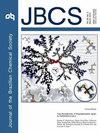UPLC-QTOF-MSE-Based Metabolic Profile to Screening Candidates of Biomarkers of Dwarf-Cashew Clones Resistant and Susceptible to Anthracnose (Colletotrichum gloeosporioides (Penz) Penz. & Sacc.)
IF 1.3
4区 化学
Q3 CHEMISTRY, MULTIDISCIPLINARY
引用次数: 0
Abstract
Investigating specialized plant metabolites, traditionally referred to as ‘secondary metabolites’ present in leaf extracts of cashew trees (Anacardium occidentale) resistant and susceptible to anthracnose disease was carried out using metabolomics combined with chemometric tools. We used clones of dwarf-cashew with the following variations of characteristics: resistant and healthy (CCP 76, BRS 226, BRS 189), susceptible and healthy (BRS 265), and another clone also susceptible but affected by the disease (BRS 265). The UPLC-QTOF-MSE (ultra performance liquid chromatography coupled with quadrupole time-of-flight mass spectrometry) analysis of the leaves of Anacardium clones allowed us annotation a total of 39 metabolites. The multiple orthogonal partial discriminant analysis of the least-squares (OPLS-DA) allowed twelve metabolites to be potential biomarkers of differentiation among the clones studied. Namely, the triene-(17:3)-anacardic acid found on CCP 76 and BRS 189 clones, respectively, is the main candidate for biomarker of resistance. While catechin, B-type procyanidin isomers, and procyanidin dimer monogallate identified in BRS 265 are significant potential biomarkers of susceptibility.基于uplc - qtof - mse的矮秆腰果无性系抗、感炭疽病生物标志物筛选& Sacc。)
利用代谢组学与化学计量学相结合的工具,研究了对炭疽病具有抗性和易感性的腰果树(Anacardium occidentale)叶子提取物中存在的特殊植物代谢物,传统上称为“次生代谢物”。我们使用了具有以下特征变化的矮腰果克隆:抗性和健康(CCP 76, BRS 226, BRS 189),易感和健康(BRS 265),以及另一个易感但受疾病影响的克隆(BRS 265)。利用超高效液相色谱-四极杆飞行时间质谱法(UPLC-QTOF-MSE)对Anacardium无性系叶片进行分析,共鉴定出39种代谢物。通过最小二乘(OPLS-DA)的多重正交偏判别分析,发现12种代谢物可作为研究克隆间分化的潜在生物标志物。即,在CCP 76和BRS 189克隆上分别发现的三烯-(17:3)-无心性酸是耐药生物标志物的主要候选。而在BRS 265中发现的儿茶素、b型原花青素异构体和原花青素二聚体是重要的潜在易感性生物标志物。
本文章由计算机程序翻译,如有差异,请以英文原文为准。
求助全文
约1分钟内获得全文
求助全文
来源期刊
CiteScore
2.90
自引率
7.10%
发文量
99
审稿时长
3.4 months
期刊介绍:
The Journal of the Brazilian Chemical Society embraces all aspects of chemistry except education, philosophy and history of chemistry. It is a medium for reporting selected original and significant contributions to new chemical knowledge.

 求助内容:
求助内容: 应助结果提醒方式:
应助结果提醒方式:


